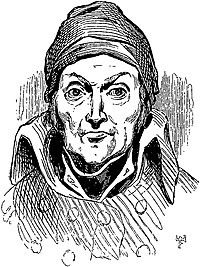Nicolas Appert
Nicolas Appert (17 November 1749 Châlons-en-Champagne, Marne– 1 Juin 1841 Massy), wis the French inventor o airtight fuid preservation. He is kent as the "faither o cannin".[1]

Biography
eeditHe wis a confectioner an chef in Paris frae 1784 tae 1795. In 1795, he began experimentin wi ways tae preserve fuidstuffs, succeedin wi soups, vegetables, juices, dairy products, jellies, jams, an syrups. He placed the fuid in gless jars, sealed them wi cork an sealin wax an placed them in boilin watter.[2]
Efter some 14 or 15 years o experiment, Appert submittit his invention an wan the prize o 12,000 francs in Januar 1810. The same year[3], Appert published L'Art de conserver les substances animales et végétales (or The Airt o Preservin Animal an Vegetable Substances). This wis the first ceukbeuk o its kynd on modren fuid preservation methods[4],[5]
La Maison Appert (Inglis: The House of Appert), in the toun o Massy, near Paris, became the first fuid bottlin factory in the warld [2], nearly 100 years afore Louis Pasteur proved that heat killed bacteria. Appert patentit his invention an establisht a business te preserve a variety o fuid in sealed bottles. Appert's method wis tae fill thick, lairge-mouthed gless bottles wi produce o ivery description, rangin frae beef, fowl, eggs, milk, an prepared dishes (accordin tae soorces). His greatest success for publicity wis an entire sheep. He left air space at the tap o the bottle, an the cork wad then be sealed firmly in the jar bi uisin a vise. The bottle wis then wrapped in canvas tae pertect it, while it wis dunked intae boilin watter an then boiled for as muckle time as Appert deemed appropriate for ceukin the contents thoroughly.
In honour o Appert, cannin is whiles cawed "appertisation", but shoud be distinguisht frae pasteurization. Appert's early attempts at fuid preservation bi boilin involved ceukin the fuid tae a temperature far in excess o wha is uised in pasteurization (70 °C (158 °F), an can destroy some o the flavour o the preserved fuid.
Appert's method wis sae semple an wirkable, that it quickly became widespread. In 1810, Breetish inventor an merchant Peter Durand an aa o French oreegin, patentit his awn method, but this time in a tin can, sae creatin the modren-day process o cannin fuids. In 1812 Inglismen Bryan Donkin an John Hall purchased baith patents an began producin preserves. Juist a decade later, the Appert method o cannin haed made its wey tae Americae. Tin can mass production wis housomeivver no common till the beginnin o the 20t century, pairtly acause the thay wur difficult tae open till the can opener wis inventit. A hammer an chisel wur needit tae open cans till the invention o a can opener bi an Inglishman named Yates in 1855.[2]
References
eedit- ↑ Jean-Paul Barbier Nicolas Appert inventeur et humaniste, Royer, 1994, Paris.
- ↑ a b c Lance Day, Ian McNeil, ed. (1996). Biographical Dictionary of the History of Technology. Routledge. ISBN 0-415-19399-0.
- ↑ Gordon L. Robertson, Food Packaging: Principles and Practice, Marcel Dekker, 1998, p. 187
- ↑ The First Book on Modern Food Preservation Methods (1810) Archived 2011-01-01 at the Wayback Machine
- ↑ Nicolas Appert in 1810 was probably the first person ...
Freemit airtins
eedit| Wikimedia Commons haes media relatit tae Nicolas Appert. |